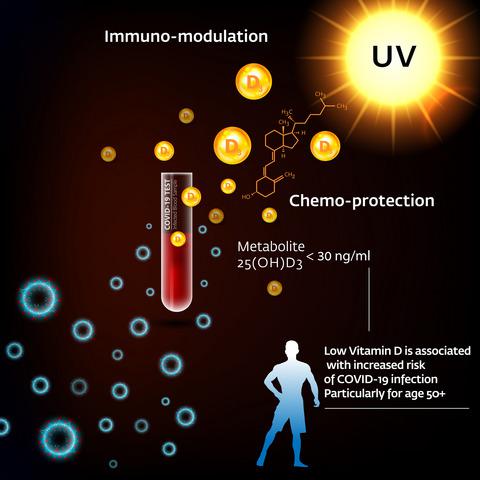Our official English website, www.x-mol.net, welcomes your
feedback! (Note: you will need to create a separate account there.)
Low plasma 25(OH) vitamin D level is associated with increased risk of COVID-19 infection: an Israeli population-based study.
The FEBS Journal ( IF 5.5 ) Pub Date : 2020-07-23 , DOI: 10.1111/febs.15495 Eugene Merzon 1, 2 , Dmitry Tworowski 3 , Alessandro Gorohovski 3 , Shlomo Vinker 1, 2 , Avivit Golan Cohen 1, 2 , Ilan Green 1, 2 , Milana Frenkel-Morgenstern 3
The FEBS Journal ( IF 5.5 ) Pub Date : 2020-07-23 , DOI: 10.1111/febs.15495 Eugene Merzon 1, 2 , Dmitry Tworowski 3 , Alessandro Gorohovski 3 , Shlomo Vinker 1, 2 , Avivit Golan Cohen 1, 2 , Ilan Green 1, 2 , Milana Frenkel-Morgenstern 3
Affiliation

|
Vitamin D deficiency is a worldwide pandemic. The aim of this study was to evaluate associations of plasma 25(OH)D levels with the likelihood of coronavirus disease 2019 (COVID‐19) infection and hospitalization. The study population included the 14 000 members of Leumit Health Services, who were tested for COVID‐19 infection from February 1st to April 30th, 2020, and who had at least one previous blood test for the plasma 25(OH)D level. ‘Suboptimal’ or ‘low’ plasma 25(OH)D level was defined as plasma 25‐hydroxyvitamin D, or 25(OH)D, concentration below the level of 30 ng/mL. Of 7807 individuals, 782 (10.02%) were COVID‐19‐positive, and 7025 (89.98%) COVID‐19‐negative. The mean plasma vitamin D level was significantly lower among those who tested positive than negative for COVID‐19 [19.00 ng/mL (95% confidence interval (CI) 18.41–19.59) vs. 20.55 (95% CI: 20.32–20.78)]. Univariate analysis demonstrated an association between the low plasma 25(OH)D level and increased likelihood of COVID‐19 infection [crude odds ratio (OR) of 1.58 (95% CI: 1.24–2.01, P < 0.001)], and of hospitalization due to the SARS‐CoV‐2 virus [crude OR of 2.09 (95% CI: 1.01–4.30, P < 0.05)]. In multivariate analyses that controlled for demographic variables, and psychiatric and somatic disorders, the adjusted OR of COVID‐19 infection [1.45 (95% CI: 1.08–1.95, P < 0.001)] and of hospitalization due to the SARS‐CoV‐2 virus [1.95 (95% CI: 0.98–4.845, P = 0.061)] were preserved. In the multivariate analyses, age over 50 years, male gender and low–medium socioeconomic status were also positively associated with the risk of COVID‐19 infection; age over 50 years was positively associated with the likelihood of hospitalization due to COVID‐19. We concluded that low plasma 25(OH)D levels appear to be an independent risk factor for COVID‐19 infection and hospitalization.
中文翻译:

低血浆 25(OH) 维生素 D 水平与 COVID-19 感染风险增加有关:一项基于以色列人群的研究。
维生素 D 缺乏症是一种全球性流行病。本研究的目的是评估血浆 25(OH)D 水平与 2019 年冠状病毒病 (COVID‐19) 感染和住院的可能性之间的关系。研究人群包括 Leumit Health Services 的 14 000 名成员,他们在 2 月 1日至 4 月 30 日期间接受了COVID -19 感染检测, 2020 年,并且之前至少进行过一次血浆 25(OH)D 水平的血液测试。“次优”或“低”血浆 25(OH)D 水平定义为血浆 25-羟基维生素 D 或 25(OH)D 浓度低于 30 ng/mL 水平。在 7807 人中,782 人(10.02%)为 COVID-19 阳性,7025 人(89.98%)为 COVID-19 阴性。COVID-19 检测呈阳性的患者的平均血浆维生素 D 水平显着低于阴性 [19.00 ng/mL(95% 置信区间 (CI) 18.41–19.59)与 20.55(95% CI:20.32–20.78)] . 单变量分析表明,低血浆 25(OH)D 水平与 COVID-19 感染的可能性增加[粗比值比 (OR) 为 1.58 (95% CI: 1.24–2.01, P < 0.001)] 和住院率之间存在关联由于 SARS-CoV-2 病毒 [粗 OR 为 2.09 (95% CI: 1.01–4.30,P < 0.05)]。在控制人口统计学变量、精神和躯体疾病的多变量分析中,调整了 COVID-19 感染 [1.45 (95% CI: 1.08–1.95, P < 0.001)] 和因 SARS-CoV-2 住院的 OR病毒 [1.95 (95% CI: 0.98–4.845, P = 0.061)] 被保留。在多变量分析中,年龄超过 50 岁、男性和中低社会经济地位也与 COVID-19 感染风险呈正相关;年龄超过 50 岁与因 COVID-19 住院的可能性呈正相关。我们得出结论,低血浆 25(OH)D 水平似乎是 COVID-19 感染和住院的独立危险因素。
更新日期:2020-09-09
中文翻译:

低血浆 25(OH) 维生素 D 水平与 COVID-19 感染风险增加有关:一项基于以色列人群的研究。
维生素 D 缺乏症是一种全球性流行病。本研究的目的是评估血浆 25(OH)D 水平与 2019 年冠状病毒病 (COVID‐19) 感染和住院的可能性之间的关系。研究人群包括 Leumit Health Services 的 14 000 名成员,他们在 2 月 1日至 4 月 30 日期间接受了COVID -19 感染检测, 2020 年,并且之前至少进行过一次血浆 25(OH)D 水平的血液测试。“次优”或“低”血浆 25(OH)D 水平定义为血浆 25-羟基维生素 D 或 25(OH)D 浓度低于 30 ng/mL 水平。在 7807 人中,782 人(10.02%)为 COVID-19 阳性,7025 人(89.98%)为 COVID-19 阴性。COVID-19 检测呈阳性的患者的平均血浆维生素 D 水平显着低于阴性 [19.00 ng/mL(95% 置信区间 (CI) 18.41–19.59)与 20.55(95% CI:20.32–20.78)] . 单变量分析表明,低血浆 25(OH)D 水平与 COVID-19 感染的可能性增加[粗比值比 (OR) 为 1.58 (95% CI: 1.24–2.01, P < 0.001)] 和住院率之间存在关联由于 SARS-CoV-2 病毒 [粗 OR 为 2.09 (95% CI: 1.01–4.30,P < 0.05)]。在控制人口统计学变量、精神和躯体疾病的多变量分析中,调整了 COVID-19 感染 [1.45 (95% CI: 1.08–1.95, P < 0.001)] 和因 SARS-CoV-2 住院的 OR病毒 [1.95 (95% CI: 0.98–4.845, P = 0.061)] 被保留。在多变量分析中,年龄超过 50 岁、男性和中低社会经济地位也与 COVID-19 感染风险呈正相关;年龄超过 50 岁与因 COVID-19 住院的可能性呈正相关。我们得出结论,低血浆 25(OH)D 水平似乎是 COVID-19 感染和住院的独立危险因素。











































 京公网安备 11010802027423号
京公网安备 11010802027423号